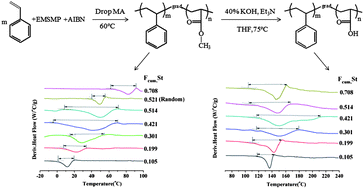Gradient copolymers of styrene–methyl acrylate and styrene–acrylic acid by organostibine-mediated controlled/living radical polymerization and their glass transition behaviors†
Abstract
Gradient

* Corresponding authors
a
Institute of Polymer Chemistry and Physics, Beijing Key Laboratory of Energy Conversion and Storage Materials, College of Chemistry, Beijing Normal University, Beijing 100875, P. R. China
E-mail:
jun@bnu.edu.cn
Fax: +86-10-58802075
Tel: +86-10-58806896
Gradient

 Please wait while we load your content...
Something went wrong. Try again?
Please wait while we load your content...
Something went wrong. Try again?
J. Zhang, J. Li, L. Huang and Z. Liu, Polym. Chem., 2013, 4, 4639 DOI: 10.1039/C3PY00484H
To request permission to reproduce material from this article, please go to the Copyright Clearance Center request page.
If you are an author contributing to an RSC publication, you do not need to request permission provided correct acknowledgement is given.
If you are the author of this article, you do not need to request permission to reproduce figures and diagrams provided correct acknowledgement is given. If you want to reproduce the whole article in a third-party publication (excluding your thesis/dissertation for which permission is not required) please go to the Copyright Clearance Center request page.
Read more about how to correctly acknowledge RSC content.
 Fetching data from CrossRef.
Fetching data from CrossRef.
This may take some time to load.
Loading related content
